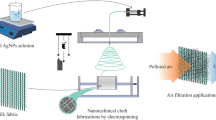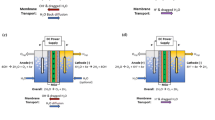Abstract
To address the issue of low mechanical strength in self-supported hollow fiber membranes, a research study was conducted to fabricate polysulfone braid-reinforced hollow fiber (PSF BRHF) membranes for natural gas purification. In this study, polyethylene (PET) was used as a braid support. PSF BRHF membranes were fabricated by employing dip coating and drying technique. The BRHF membranes underwent comprehensive analysis, including the manipulation of polymer (PSF) concentration (15 wt%, 18 wt%, and 21 wt%) and the number of coating layers (1–4). Characterization of the fabricated membrane samples involved scanning electron microscopy (SEM), thermogravimetric analysis (TGA), differential scanning calorimetry (DSC), gas separation performance testing, and mechanical strength testing. The results indicated that membranes fabricated with higher polymer concentrations exhibited a denser structure with a thicker separation layer. An increase in the separation layer thickness was also observed with an increasing number of coating layers. Importantly, all fabricated membrane samples demonstrated remarkable thermal stability. To assess the performance, gas separation tests were conducted using pure gases at 3 bar. Notably, the membrane sample with 21 wt% PSF and the 3rd coating layer (21_3 PSF) exhibited the most promising gas separation performance among all the samples selected to carry out the separation performance test, achieving a CO2/CH4 selectivity of 1.83. Mechanical strength testing revealed that 21_3 PSF BRHF (68.2 MPa) fabricated in this study outperformed conventional self-supported PSF hollow fiber membranes (9.44 MPa), as reported in the literature. These findings underscore the potential of BRHF membranes for natural gas purification, although further improvements are still possible.
















Similar content being viewed by others
Data availability
The data will be available on request from corresponding authors.
References
Tabe-Mohammadi A (1999) A review of the applications of membrane separation technology in natural gas treatment. Sep Sci Technol 34(10):2095–2111
Speight JG, (2014) Oil and gas corrosion prevention: From surface facilities to refineries. Gulf Professional Publishing.
Han Y, Ho WSW (2021) Polymeric membranes for CO2 separation and capture. J Membr Sci 628:119244
Chong K et al (2016) Recent progress of oxygen/nitrogen separation using membrane technology. J Eng Sci Technol 11:1016–1030
Ebrahimi A et al (2015) Energetic, exergetic and economic assessment of oxygen production from two columns cryogenic air separation unit. Energy 90:1298–1316
Kargari A, Rezaeinia S (2020) State-of-the-art modification of polymeric membranes by PEO and PEG for carbon dioxide separation: a review of the current status and future perspectives. J Ind Eng Chem 84:1–22
Wallace DW, Staudt-Bickel C, Koros WJ (2006) Efficient development of effective hollow fiber membranes for gas separations from novel polymers. J Membr Sci 278(1–2):92–104
Javaid A (2005) Membranes for solubility-based gas separation applications. Chem Eng J 112(1–3):219–226
Samuel O et al (2022) Treatment of oily wastewater using photocatalytic membrane reactors: a critical review. J Environ Chem Eng 10(6):108539
Zhang Z, Fuoco A, He G (2021) Membranes for gas separation. Membranes (Basel) 11(10):755
Sridhar S, Bee S, and Bhargava SK, (2014) Membrane-based gas separation: principle, applications and future potential. Chem. Eng. Dig, 1–25.
Lasseuguette E, Comesaña-Gándara B (2022) Polymer membranes for gas separation. Membranes (Basel) 12(2):207
Namboodiri VV, Vane LM (2007) High permeability membranes for the dehydration of low water content ethanol by pervaporation. J Membr Sci 306(1–2):209–215
Imtiaz A et al (2023) A critical review in recent progress of hollow fiber membrane contactors for efficient CO2 separations. Chemosphere 325:138300
Samuel O et al (2023) Photocatalytic degradation of recalcitrant aromatic hydrocarbon compounds in oilfield-produced water: a critical review. J Clean Prod 415:137567
Peng N et al (2012) Evolution of polymeric hollow fibers as sustainable technologies: past, present, and future. Prog Polym Sci 37(10):1401–1424
Turken T et al (2019) Progress on reinforced braided hollow fiber membranes in separation technologies: a review. J Water Process Eng 32:100938
Kamaludin R et al (2023) ZIF-8-based dual layer hollow fiber mixed matrix membrane for natural gas purification. Fuel 354:129377
Mahon HI, (1966) Permeability separatory apparatus, permeability separatory membrane element, method of making the same and process utilizing the same. Google Patents.
Imtiaz A et al (2022) Challenges, opportunities and future directions of membrane technology for natural gas purification: a critical review. Membranes (Basel) 12(7):646
Goh K et al (2015) Graphene oxide as effective selective barriers on a hollow fiber membrane for water treatment process. J Membr Sci 474:244–253
Quan Q et al (2014) Preparation and properties of two-dimensional braid heterogeneous-reinforced polyvinylidene fluoride hollow fiber membrane. Adv Mater Res. 936:218–225
Imtiaz A et al (2022) ZIF-filler incorporated mixed matrix membranes (MMMs) for efficient gas separation: a review. J Environ Chem Eng 10(6):108541
Fuke M, Kuroki T, and Tanaka T, (2002) Polysulfone-base hollow-fiber hemocathartic membrane and processes for the production thereof. Google Patents.
Ismail A et al (1999) Production of super selective polysulfone hollow fiber membranes for gas separation. Polymer 40(23):6499–6506
Kneifel K, Peinemann K-V (1992) Preparation of hollow fiber membranes from polyetherimide for gas separation. J Membr Sci 65(3):295–307
Lee MS, Choi SH, and Shin YC, (2008) Braid-reinforced hollow fiber membrane. 2008, Google Patents.
Cooper, W.W. and E.M. Shea, Process for casting integrally supported tubular membranes. 1972, Google Patents.
Hayano F, Hashino Y, and Ichikawa K, (1977) Semipermeable composite membranes. Google Patents.
Quan Q, et al., (2015) Preparation and characterization of braided tube reinforced polyacrylonitrile hollow fiber membranes. J Appl Polym Sci. 132(14).
Fan Z et al (2015) Structure design and performance study on braid-reinforced cellulose acetate hollow fiber membranes. J Membr Sci 486:248–256
Lee MS, Choi SH, and Shin YC, (2007) Braid-reinforced hollow fiber membrane, Google Patents.
Hao J et al (2016) Preparation and performance of PET-braid-reinforced poly (vinylidene fluoride)/graphene hollow-fiber membranes. Ind Eng Chem Res 55(7):2174–2182
Zhou Z et al (2018) Improving bonding strength between a hydrophilic coating layer and poly (ethylene terephthalate) braid for preparing mechanically stable braid-reinforced hollow fiber membranes. J Appl Polym Sci 135(14):46104
Chen M et al (2017) Study on the structural design and performance of novel braid-reinforced and thermostable poly (m-phenylene isophthalamide) hollow fiber membranes. RSC Adv 7(33):20327–20335
Liu H et al (2017) Preparation and performance of braid-reinforced poly (vinyl chloride) hollow fiber membranes. J Appl Polym Sci 134(28):45068
Liu J et al (2009) Preparation of PET threads reinforced PVDF hollow fiber membrane. Desalination 249(2):453–457
Turken T et al (2021) Fabrication and characterization of polysulfone reinforced hollow fibre membrane. Environ Technol 42(17):2690–2699
Quan Q et al (2014) Preparation and properties of two-dimensional braid heterogeneous-reinforced polyvinylidene fluoride hollow fiber membrane. Adv Mater Res 936:218–225
Zhang Q et al (2016) Fabrication of TiO2 nanofiber membranes by a simple dip-coating technique for water treatment. Surf Coat Technol 298:45–52
Chong KC et al (2018) Preparation, characterization, and performance evaluation of polysulfone hollow fiber membrane with PEBAX or PDMS coating for oxygen enhancement process. Polymers 10(2):126
Wahab MSA, Abd Rahman S, (2018) The effect number of PebaxÒ 1657 coating layer on thin film composite (TFC) membrane for CO2/N2 separation.
Abedini R, Nezhadmoghadam A (2010) Application of membrane in gas separation processes: its suitability and mechanisms. Pet Coal 52(2):69–80
Karim SS et al (2022) The influence of polymer concentration on the morphology and mechanical properties of asymmetric polyvinyl alcohol (PVA) membrane for O2/N2 separation. Polym Polym Compos 30:09673911221090053
Sharip MS, Sazali N, Ahmad FN (2020). Effect of polymer concentration on matrimid 5218 based-carbon membrane for H2 separation. J Appl Memb Sci Technol, 24(1), https://doi.org/10.11113/amst.v24n1.175
Kluge S, Kose T, Tutuş M (2022) Tuning the morphology and gas separation properties of polysulfone membranes. Membranes 12(7):654
Ismail AF, Lai PY (2003) Effects of phase inversion and rheological factors on formation of defect-free and ultrathin-skinned asymmetric polysulfone membranes for gas separation. Sep Purif Technol 33(2):127–143
Julian H, Wenten I (2012) Polysulfone membranes for CO2/CH4 separation: state of the art. IOSR J Eng 2(3):484–495
Yamasaki A et al (1997) Effect of gelation conditions on gas separation performance for asymmetric polysulfone membranes. J Membr Sci 123(1):89–94
Valappil RSK, Ghasem N, Al-Marzouqi M (2021) Current and future trends in polymer membrane-based gas separation technology: a comprehensive review. J Ind Eng Chem 98:103–129
Khan IU et al (2020) ZIF-8 based polysulfone hollow fiber membranes for natural gas purification. Polym Testing 84:106415
Suleman MS, Lau K, Yeong Y (2016) Characterization and performance evaluation of PDMS/PSF membrane for CO2/CH4 separation under the effect of swelling. Proc Eng 148:176–183
Rafiq S et al (2012) Kinetics of thermal degradation of polysulfone/polyimide blended polymeric membranes. J Appl Polym Sci 123(6):3755–3763
Mustaffar M, Ismail A, and Illias R (2004) Study on the effect of polymer concentration on hollow fiber ultrafiltration membrane performance and morphology. In: Regional Symposium on Membrane Science and Technology, Malaysia. Citeseer.
Ismail A, Khulbe K, Matsuura T (2015) Membrane Fabrication/Manufacturing Techniques. Polymeric and Inorganic, Gas Separation Membranes. https://doi.org/10.1007/978-3-319-01095-3_4
Anokhina T et al (2021) Express method of preparation of hollow fiber membrane samples for spinning solution optimization: polysulfone as example. Membranes 11(6):396
Karunakaran M et al (2017) CO2-philic thin film composite membranes: Synthesis and characterization of PAN-r-PEGMA copolymer. Polymers 9(7):219
Nordin NAM et al (2015) Utilizing low ZIF-8 loading for an asymmetric PSf/ZIF8 mixed matrix membrane for CO2/CH4 separation. RSC Adv 5(38):30206–30215
Farnam M, Mukhtar H, Shariff A (2015) Investigation of optimum drying conditions for pure PES membranes for gas separation. Adv Environ Biol 9(27):326–331
Dahe G, Teotia R, Bellare J (2012) The role of zeolite nanoparticles additive on morphology, mechanical properties and performance of polysulfone hollow fiber membranes. Chem Eng J 197:398–406
Kagramanov G, Gurkin V, Farnosova E (2021) Physical and mechanical properties of hollow fiber membranes and technological parameters of the gas separation process. Membranes 11(8):583
Kotsilkova R et al (2018) Tensile and surface mechanical properties of polyethersulphone (PES) and polyvinylidene fluoride (PVDF) membranes. J Theor Appl Mech 48:85–99
Chen XY, Kaliaguine S, and Rodrigue D. (2019) Polymer hollow fiber membranes for gas separation: a comparison between three commercial resins. In: AIP Conference Proceedings. AIP Publishing.
Acknowledgements
The authors gratefully acknowledge Ministry of Higher Education under Science and Technology Research Partnership for Sustainable Development (SATREPS) scheme (Vot number: R.J130000.7809.4L975), and Universiti Teknologi Malaysia under the Matching Grant (Project number: Q.J130000.3009.03M15 ) and UTM Fundamental Research (UTMFR) (Project number: Q.J130000.3809.22H07). The authors also would like to thank UMW for the Contract Research Grant (Project number: R.J130000.7609.4C471).
Funding
The Funding was provided by UTM, (R.J130000.7309.4B676/Q.J130000.3009.03M23), Mohd Hafiz Dzarfan Othman
Author information
Authors and Affiliations
Corresponding authors
Ethics declarations
Conflict of interest
The authors declare that they have no conflict of interest.
Additional information
Handling Editor: Dale Huber.
Publisher's Note
Springer Nature remains neutral with regard to jurisdictional claims in published maps and institutional affiliations.
Rights and permissions
Springer Nature or its licensor (e.g. a society or other partner) holds exclusive rights to this article under a publishing agreement with the author(s) or other rightsholder(s); author self-archiving of the accepted manuscript version of this article is solely governed by the terms of such publishing agreement and applicable law.
About this article
Cite this article
Imtiaz, A., Kamaludin, R., Othman, M.H.D. et al. Synthesis and performance analysis of a polysulfone braid-supported hollow fiber membrane for natural gas purification. J Mater Sci 59, 304–323 (2024). https://doi.org/10.1007/s10853-023-09208-6
Received:
Accepted:
Published:
Issue Date:
DOI: https://doi.org/10.1007/s10853-023-09208-6




